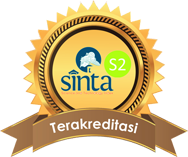Explorative Research Course: Recovering Rare Earth Elements from Electronic Waste Using Deep Eutectic Solvents
DOI:
https://doi.org/10.15575/jtk.v8i2.30087Keywords:
deep eutectic solvents, electronic waste, explorative research course, rare earth element, systems thinkingAbstract
This study aims to demonstrate how a course design approach based on explorative research involving systems thinking can be implemented by recovering Rare Earth Elements (REEs) using Deep Eutectic Solvents (DES). The method used in this research is Design-Based Research (DBR). The instruments used were questions regarding the measurement of leaching samples from results/characterization, short questions about concept maps, and student response questionnaires. Data from measurements of leaching samples was measured using a Fourier Transform Infrared Spectrometer (FTIR), data about concept maps was measured by the number of component and process concepts in the context of electronic waste recycling that students were able to identify, and student response data was measured using a Likert scale. Based on the research results, recovery of REEs can be done using DES. It can be shown by a shift in the peak vibration of 497.65 cm-1 from the sample before leaching to a vibration of 449.43 cm-1 after leaching. In addition, this study yields new insights into the perceptions of future pre-service chemistry teachers regarding the possibility of new types of DES in the context of chemistry learning. According to pre-service chemistry teachers, recovering REEs from electronic waste and applying DES are interesting as a new context for laboratory learning. Context-based design of research activities can enhance system thinking and interest in chemistry. The results of study showed increased student’s systems thinking abilities, as shown by the component and process concepts that emerged from the pre-test by 652 concepts while the post-test increased by 1208 concepts.
References
Aksela, M. (2019). Towards student-centred solutions and pedagogical innovations in science education through co-design approach within design-based research. LUMAT: International Journal on Math, Science and Technology Education, 7(3), 113–139. https://doi.org/10.31129/LUMAT.7.3.421
Anastas, P., & Eghbali, N. (2010). Green chemistry: principles and practice. Chemical Society Reviews, 39(1), 301–312. https://doi.org/10.1039/b918763b
Anastas, P. T., & Zimmerman, J. B. (2016). The molecular basis of sustainability. Chem, 1(1), 10–12. https://doi.org/10.1016/j.chempr.2016.06.016
Anderson, T., & Shattuck, J. (2012). Design-based research: A decade of progress in education research?. Educational Researcher, 41(1), 16–25. https://doi.org/10.3102/0013189X11428813
Ari, V. (2016). A review of technology of metal recovery from electronic waste. E-Waste in Transition - From Pollution to Resource. https://doi.org/10.5772/61569
Assaraf, O. B. Z., & Orion, N. (2010). System thinking skills at the elementary school level. Journal of Research in Science Teaching, 47(5), 540–563. https://doi.org/10.1002/tea.20351
Busta, L., & Russo, S. E. (2020). Enhancing interdisciplinary and systems thinking with an integrative plant chemistry module applied in diverse undergraduate course settings. Journal of Chemical Education, 97(12), 4406–4413. https://doi.org/10.1021/acs.jchemed.0c00395
Chakraborty, R., Asthana, A., Singh, A. K., Jain, B., & Susan, A. B. H. (2022). Adsorption of heavy metal ions by various low-cost adsorbents: a review. International Journal of Environmental Analytical Chemistry, 102(2), 342–379. https://doi.org/10.1080/03067319.2020.1722811
Dale, A., & Newman, L. (2005). Sustainable development, education and literacy. International Journal of Sustainability in Higher Education, 6(4), 351–362. https://doi.org/10.1108/14676370510623847
Edelson, D. C. (2002). Design research : what we learn when we engage in design. Journal of the Learning Sciences, 11(1), 105–121. https://doi.org/10.1207/S15327809JLS1101
Hernani, H., Mudzakir, A., & Sumarna, O. (2016). Ionic liquids material as modern context of chemistry in school. Jurnal Pendidikan IPA Indonesia, 5(1), 63–68. https://doi.org/10.15294/jpii.v5i1.5791
Huang, J., Guo, X., Xu, T., Fan, L., Zhou, X., & Wu, S. (2019). Ionic deep eutectic solvents for the extraction and separation of natural products. Journal of Chromatography A, 1598, 1–19. https://doi.org/10.1016/j.chroma.2019.03.046
Kareem, M. A., Mjalli, F. S., Hashim, M. A., & Alnashef, I. M. (2010). Phosphonium-based ionic liquids analogues and their physical properties. Journal of Chemical and Engineering Data, 55(11), 4632–4637. https://doi.org/10.1021/je100104v
Kisworo, B., Liliasari, S., & Mudzakir, A. (2021). The analysis of content teaching materials: Identification of potential for developing systems thinking skills in coordination chemistry. Journal of Physics: Conference Series, 1806(1), 1-6. https://doi.org/10.1088/1742-6596/1806/1/012208
Kisworo, B., Mudzakir, A., & Liliasari, S. (2021). How does chemistry of rare earth metals coordination complexes can enhance system thinking ability ? A qualitative content analysis study. Moroccan Journal of Chemistry, 9(2), 301–311. https://doi.org/10.48317/IMIST.PRSM/morjchem-v9i2.27582
Kisworo, B., Mudzakir, A., Liliasari, S., Permanasari, A., & Novia, N. (2023). Twenty years of research development on systems thinking in rare earth coordination chemistry : a bibliometric analysis. Journal of Engineering Science and Technology, 18(3), 137–144. Retrieved from https://jestec.taylors.edu.my/Special%20Issue%20ISCoE%202022_2/ISCoE%202_18.pdf
Mahaffy, P. G., Brush, E. J., Haack, J. A., & Ho, F. M. (2018). Journal of chemical education call for papers - special issue on reimagining chemistry education: systems thinking, and green and sustainable chemistry. Journal of Chemical Education, 95(10), 1689–1691. https://doi.org/10.1021/acs.jchemed.8b00764
Mahaffy, P. G., Matlin, S. A., Holme, T. A., & MacKellar, J. (2019). Systems thinking for education about the molecular basis of sustainability. Nature Sustainability, 2(5), 362–370. https://doi.org/10.1038/s41893-019-0285-3
Mahaffy, P. G., Matlin, S. A., Whalen, J. M., & Holme, T. A. (2019). Integrating the molecular basis of sustainability into general chemistry through systems thinking. Journal of Chemical Education, 96(12), 2730–2741. https://doi.org/10.1021/acs.jchemed.9b00390
Mairizal, A. Q., Sembada, A. Y., Tse, K. M., & Rhamdhani, M. A. (2021). Electronic waste generation, economic values, distribution map, and possible recycling system in Indonesia. Journal of Cleaner Production, 293. https://doi.org/10.1016/j.jclepro.2021.126096
Marcus, Y. (2019). Application of deep eutectic solvents. Springer International Publishing. https://doi.org/10.1007/978-3-030-00608-2_4
MartÃn-Ramos, P., Miranda, M. D., Silva, M. R., Eusebio, M. E. S., LavÃn, V., & MartÃn-Gil, J. (2013). A new near-IR luminescent erbium(III) complex with potential application in OLED devices. Polyhedron, 65(3), 187–192. https://doi.org/10.1016/j.poly.2013.08.035
Mudzakir, A., Hernani, Widhiyanti, T., & Sudrajat, D. P. (2017). Contribution from philosophy of chemistry to chemistry education: In a case of ionic liquids as technochemistry. AIP Conference Proceedings, 1-12. https://doi.org/10.1063/1.4995111
Pateli, I. M., Abbott, A. P., Binnemans, K., & Rodriguez Rodriguez, N. (2020). Recovery of yttrium and europium from spent fluorescent lamps using pure levulinic acid and the deep eutectic solvent levulinic acid-choline chloride. RSC Advances, 10(48), 28879–28890. https://doi.org/10.1039/d0ra05508e
Pernaa, J., Kämppi, V., & Aksela, M. (2022). Supporting the relevance of chemistry education through sustainable ionic liquids context: A research-based design approach. Sustainability, 14(10), 1-18. https://doi.org/10.3390/su14106220
Tripto, J., Assaraf, O. B.-Z., & Amit, M. (2013). Mapping what they know: Concept maps as an effective tool for assessing students’ systems thinking. American Journal of Operations Research, 03(01), 245–258. https://doi.org/10.4236/ajor.2013.31a022
Vanda, H., Dai, Y., Wilson, E. G., Verpoorte, R., & Choi, Y. H. (2018). Green solvents from ionic liquids and deep eutectic solvents to natural deep eutectic solvents. Comptes Rendus Chimie, 21(6), 628–638. https://doi.org/10.1016/j.crci.2018.04.002
Werby, S. H., & Cegelski, L. (2019). Design and implementation of a six-session cure module using biofilms to explore the chemistry-biology interface. Journal of Chemical Education, 96(9), 2050–2054. https://doi.org/10.1021/acs.jchemed.8b00957
Widmer, R., Oswald-Krapf, H., Sinha-Khetriwal, D., Schnellmann, M., & Böni, H. (2005). Global perspectives on e-waste. Environmental Impact Assessment Review, 25(5), 436–458. https://doi.org/10.1016/j.eiar.2005.04.001
Downloads
Published
How to Cite
Issue
Section
Citation Check
License
Authors who publish with this journal agree to the following terms:
- Authors retain copyright and grant the journal right of first publication with the work simultaneously licensed under a Creative Commons Attribution-ShareAlike that allows others to share the work with an acknowledgement of the work's authorship and initial publication in this journal.
- Authors are able to enter into separate, additional contractual arrangements for the non-exclusive distribution of the journal's published version of the work (e.g., post it to an institutional repository or publish it in a book), with an acknowledgement of its initial publication in this journal.
- Authors are permitted and encouraged to post their work online (e.g., in institutional repositories or on their website) prior to and during the submission process, as it can lead to productive exchanges, as well as earlier and greater citation of published work (See The Effect of Open Access).








